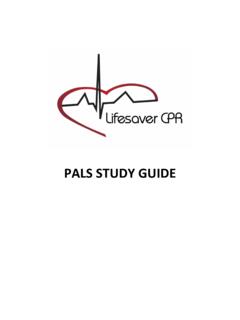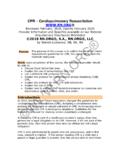Transcription of CPR Guidelines – Infant (Less than 1 year old)
1 2006 CPR Guidelines Infant (Less than 1 year old) CPR Infant (< 1 year old) New Old Attempt to Give Two Effective Breaths Infant Healthcare providers should try a couple of times to deliver 2 effective breaths (breaths that cause visible chest rise to the Infant or child . Healthcare providers were told to move the child s head through a variety of positions to obtain optimal airway opening and effective rescue breaths. Rescue Breathing Without Chest Compressions Infant If the unresponsive victim is not breathing but has a pulse, the healthcare provider will give rescue breathing without chest compressions. The provider will deliver 12 to 20 breaths per minute for an Infant or child (approximately 1 breath every 3 to 5 seconds).)
2 Healthcare providers delivered 20 breaths per minute for the Infant or child . Rescue Breaths With Chest Compressions Infant All rescuers should deliver each rescue breath during CPR over 1 second. The volume of each rescue breath should be sufficient to produce visible chest rise. Rescuers should avoid delivering more breaths than are recommended or breaths that are too large or too forceful. Various tidal volumes were recommended and rescuers were taught to deliver them over 1 to 2 seconds. Chest Compressions Recommended for Symptomatic Bradycardia Infant If despite adequate oxygenation and ventilation, the heart rate of the Infant or child is <60 bpm with signs of poor systemic perfusion, the healthcare provider should begin chest compressions.
3 This same recommendation was contained in the 2000 Guidelines ; however, it was not incorporated in BLS training. Emphasis on Chest Compression Depth and Rate, Chest Wall Recoil, Minimal Interruptions Infant Effective chest compressions are essential to provide blood flow during CPR. The 2005 Guidelines emphasize that the rescuer should push hard, push fast, and allow the chest to recoil after each compression. Push fast at a rate of 100 per minute; allow full chest recoil after each compression. The recommendations for depth and rate of chest compressions were the same. Less emphasis was given to the need for adequate depth of compression, complete recoil of the chest, and minimizing interruptions in the chest compressions.
4 Rescuers Should Change Compressors Every 2 Minutes Infant When more than 1 rescuer is present, rescuers should change compressor roles about every 2 minutes. When the first rescuer performing chest compressions becomes fatigued, the rescuers should change positions with minimal interruptions in chest compressions. Refinement of Instructions for Chest Compressions During 2-Rescuer CPR Infant Healthcare providers should use the 2 thumb-encircling hands technique for 2-rescuer CPR for infants. With this technique the healthcare provider forcefully compresses the sternum with the thumbs while using the fingers to squeeze the thorax. The 2 thumb-encircling hands technique was the preferred technique for 2-rescuer healthcare provider CPR for infants.
5 Simultaneous compression of the chest wall with the fingers was not described. New Old Compression-to-Ventilation Ratios Infant Rescuers performing 2-rescuer CPR should use a 15:2 ratio for infants and for children (aged 1 year until the onset of puberty). A compression-to-ventilation ratio of 15:2 for adults and a compression-to-ventilation ratio of 5:1 for infants and children were recommended. 2-Rescuer CPR With an Advanced Airway Infant Healthcare providers should deliver cycles of compressions and ventilations during CPR when there is no advanced airway ( , endotracheal tube) in place. Once an advanced airway is in place for Infant , child , or adult victims, 2 rescuers no longer deliver cycles of compressions interrupted with pauses for ventilation.
6 Instead, the compressing rescuer should deliver 100 compressions per minute continuously, without pauses for ventilation. The rescuer delivering the rescue breaths (ventilations) should give 8 to 10 breaths per minute for infants and should be careful to avoid delivering an excessive number of ventilations. A ventilation rate of about 8 to 10 breaths per minute will be the equivalent of giving 1 breath about every 6 to 8 seconds. Former Guidelines recommended asynchronous compressions and ventilations (compressions and ventilations not timed with one another) during CPR when an advanced airway is in place. A ventilation rate of 12 to 20 per minute was recommended for infants during CPR with an advanced airway.
7 Streamlining Actions for Relief of Foreign-Body Airway Obstruction Infant Relieving Choking in the Responsive Infant : Clearing an object from an Infant s airway requires a combination of back slaps and chest thrusts. 1 Kneel or sit with the Infant in your lap. 2 If it is easy to do, bare the Infant s chest. 3 Hold the Infant prone (facedown) with the head slightly lower than the chest, resting on your forearm. Support the Infant s head and jaw with your hand. Take care to avoid compressing the soft tissues of the Infant s throat. Rest your forearm on your lap or thigh to support the Infant . 4 Deliver up to 5 back slaps forcefully in the middle of the back between the Infant s shoulder blades, using the heel of your hand.
8 Deliver each slap with sufficient force to attempt to dislodge the foreign body. 5 - After delivering up to 5 back slaps, place your free hand on the Infant s back, supporting the back of the Infant s head with the palm of your hand. The Infant will be adequately cradled between your two Back slaps, chest thrust, and ventilation. New Old CONTINUED Streamlining Actions for Relief of Foreign-Body Airway Obstruction Infant forearms, with the palm of one hand supporting the face and jaw while the palm of the other hand supports the back of the Infant s head. 6 Turn the Infant as a unit while carefully supporting the head and neck. Hold the Infant on his back with your forearm resting on your thigh.
9 Keep the Infant s head lower than the trunk. 7 Provide up to 5 quick downward chest thrusts in the same location as chest compressions just below the nipple line. Deliver chest thrusts at a rate of about 1 per second, each with the intention of creating enough of an artificial cough to dislodge the foreign body. 8 Repeat the sequence of up to 5 back slaps and up to 5 chest thrusts until the object is removed or the Infant becomes unresponsive. Relieving Choking in the Unresponsive Infant : 1 Place the Infant on a firm, flat surface. 2 Open the Infant s airway and look for an object in the pharynx. If an object is visible, remove it. Do not perform a blind finger sweep.
10 3 Begin CPR with 1 extra step: each time you open the airway, look for the obstructing object in the back of the throat. If you see an object, remove it. 4 After approximately 5 cycles (about 2 minutes) of CPR, activate the emergency response system. Back slaps, chest thrust, and ventilation.





